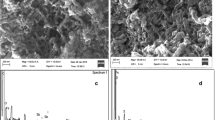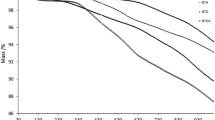Abstract
Chemical reduction of 4-chloro-2-nitrobenzenediazonium chloride salt in the presence of hypophosphorous acid and carbon powder results in functionalized carbon powder with chloronitrophenyl groups attached on carbon particle surface. This type of bulk derivatization protocol is very useful and most inexpensive compared to widely used electrochemically assisted derivatization protocol. The derivatized carbon powder has been characterized by studying its Fourier transform infrared spectroscopy (FTIR) and cyclic voltammetric studies. The surface functionalized moieties have been examined electrochemically by immobilizing them onto the surface of basal plane pyrolytic graphite electrode and studying its cyclic voltammetry. The effect of pH, scan rate (v), and the peak potentials (E p) as a function of pH has revealed that the species are surface bound in nature and covalently attached on the carbon surface. The FTIR studies of the derivatized carbon powder have revealed that the modifying molecule is covalently attached on the carbon particle surface.









Similar content being viewed by others
References
Downard AJ (2000) Electroanalysis 12:1085
Pandurangappa M, Lawrence NS, Compton RG (2002) Analyst 127:1568
Pandurangappa M, Lawrence NS, Jiang L, Jones TGJ, Compton RG (2003) Analyst 128:473
Wildgoose GG, Lawrence NS, Leventis HC, Jiang L, Jones TGJ, Compton RG (2005) J Mater Chem 15:953
Wildgoose GG, Pandurangappa M, Lawrence NS, Jiang L, Jones TGJ, Compton RG (2003) Talanta 60:887
Leventis HC, Streeter I, Wildgoose GG, Lawrence NS, Jiang L, Jones TGJ, Compton RG (2004) Talanta 63:1039
Streeter I, Leventis HC, Wildgoose GG, Pandurangappa M, Lawrence NS, Jiang L, Jones TGJ, Compton RG (2004) J Solid State Electrochem 8:718
Wildgoose GG, Leventis HC, Davies IJ, Crossley A, Lawrence NS, Jiang L, Jones TGJ, Compton RG (2005) J Mater Chem 15:2375
Wildgoose GG, Leventis HC, Streeter I, Lawrence NS, Wilkins SJ, Jiang L, Jones TGJ, Compton RG (2004) Chem Phys Chem 5:669
Pandurangappa M, Ramakrishnappa T (2006) Electroanalysis 18:2290
Kondo T, Kanai T, Uosaki K (2001) Langmuir 17:6317
Chakraborty S, Chattopadhyay J, Peng H, Chen Z, Mukherjee A, Arvidson RS, Hauge RH, Billups WE (2006) J Phys Chem B 110:24812
Barbara P, Michael H, Siegmar R (2005) Carbon 43:2209
Wildgoose GG, Hyde ME, Lawrence NS, Leventis HC, Jiang L, Jones TGJ, Compton RG (2005) Langmuir 21:4584
Ye Y, Ahn CC, Witham C, Fultz B, Liu J, Rinzler AG, Colbert D, Smith KA, Smalley RE (1999) Appl Phys Lett 74:2307
Silverstein RM, Bassler GC, Morrill TC (1991) Spectrometric identification of organic compounds. Wiley, New York, p 127
Zierkiewicz W, Michalska D, Huyskens TZ (2000) J Phys Chem A 104:11685
Acknowledgements
The authors acknowledge the financial support and award of the fellowship to TR by the Department of Science and Technology, New Delhi, India and also the financial support from UGC-DRS (Phase IV) program of the Department of Chemistry, Bangalore University.
Author information
Authors and Affiliations
Corresponding author
Rights and permissions
About this article
Cite this article
Pandurangappa, M., Ramakrishnappa, T. Derivatization and characterization of functionalized carbon powder via diazonium salt reduction. J Solid State Electrochem 12, 1411–1419 (2008). https://doi.org/10.1007/s10008-007-0470-6
Received:
Revised:
Accepted:
Published:
Issue Date:
DOI: https://doi.org/10.1007/s10008-007-0470-6




